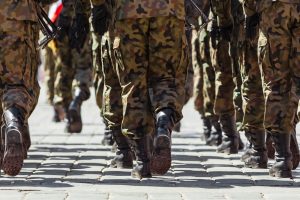When comparing military boot camps, each branch of the U.S. Armed Forces puts its unique spin on preparing recruits. For the Army, basic training, formally known as Basic Combat Training (BCT), typically lasts around 10 weeks but can take up to 14 weeks. This period is structured into various phases, each designed to equip recruits with essential skills.
To put it into perspective:
- Marines: Their rigorous training program extends to about 13 weeks, emphasizing resilience and battlefield readiness.
- Navy: Navy boot camp lasts approximately 7 weeks and focuses on naval protocol and seamanship.
- Air Force: Known as Basic Military Training (BMT), it covers about 8.5 weeks, with an emphasis on technical skills and aerial operations.
- Coast Guard: This branch conducts an 8-week training course concentrated on maritime safety and security.
These durations can slightly vary based on individual circumstances, such as assigned military roles, which may alter the length of the training. However, recruits can generally expect Army basic training to run its course over 10 weeks, including the graduation ceremony.

US Army Basic Training: What to Expect and How Long it Lasts
Phases of Basic Training: The training is divided into three phases, each with its own set of challenges and goals:
Red Phase (Weeks 1-3)
The Red Phase is the initial phase of Basic Training, where new recruits undergo intense physical training, learn Army core values, and develop basic combat skills. Over the course of these three weeks, you’ll be introduced to the fundamentals of soldiering, including teamwork, integrity, and discipline, which are essential to embodying the Warrior Ethos.
During this phase, you’ll face the Army Combat Fitness Test (ACFT), a comprehensive assessment designed to measure your physical capabilities. This test replaces the previous Army Physical Fitness Test (APFT) and includes six key components:
- 3 Repetition Maximum Deadlift
- Standing Power Throw
- Hand Release Push-Up — Arm Extension
- Sprint-Drag-Carry
- Leg Tuck
- Two-Mile Run
Each test evaluates different aspects of physical fitness such as strength, flexibility, and coordination. For example, the leg tuck is a crucial component that tests your muscular strength, agility, and endurance. You’ll be tasked with hanging from a bar and lifting your knees to your forearms, aiming for a high number of repetitions to score well.
To pass the ACFT, an overall minimum score of 60 is required, with each repetition in the leg tuck contributing to your total points—one rep equates to 60 points, with a maximum of 100 points achievable through 20 reps.
Beyond the fitness tests, the Red Phase includes road marching drills and basic first aid training, covering both the administration of aid and the essentials of a complete first-aid kit. You’ll also receive education on identifying and preventing sexual harassment and assault, along with training in chemical, radioactive, and biological readiness. This includes learning the proper use of protective gear like gas masks.
This foundational phase is designed to build not just your physical strength but also your knowledge and readiness as a soldier, setting the stage for the rigorous journey ahead.
White Phase (Weeks 4-5)
In the White Phase, recruits learn combat skills, such as first aid, map reading, and combat tactics. They also undergo physical training and obstacle courses.
Blue Phase (Weeks 6-10)
The Blue Phase is the final phase, during which recruits learn advanced combat skills, such as combat scenarios, patrolling, and teamwork. They also prepare for their final test, the “Army Physical Fitness Test” (APFT).
In this phase, you’ll delve deeper into the complexities of military operations. Training includes:
- Disabling Improvised Explosive Devices (IEDs): A vital skill that equips recruits with the knowledge to safely navigate and neutralize potential threats.
- Combat Maneuvering Techniques: These are advanced tactics that enhance your ability to move effectively in diverse combat scenarios.
- Advanced Weaponry Training: Comprehensive instruction on the use of sophisticated weapons systems, ensuring you’re ready for any battlefield challenge.
The culmination of these weeks involves a rigorous series of challenges that test your mastery of tactics, physical fitness capabilities, and survival skills across various environments. This final segment is designed to ensure that every recruit is fully prepared for real-world applications of their training.
Differences in Army Basic Training Experiences
When it comes to Army basic training, the experience can vary significantly depending on where you are stationed. Here’s how training locations like Fort Benning, Fort Jackson, and Fort Sill might influence your journey.
Fort Benning: The Home of the Infantry
- Environment: Known for its intense focus on combat readiness, Fort Benning places a strong emphasis on infantry skills.
- Training Routines: Expect rigorous physical challenges and an in-depth introduction to advanced weaponry.
Fort Jackson: Diversity in Training
- Focus: As the Army’s largest training center, Fort Jackson emphasizes teamwork and individual soldier skills.
- Special Programs: Offers unique opportunities in fields like finance and logistics, providing a broad range of experiences.
Fort Sill: Artillery Centerpiece
- Specialization: Fort Sill is renowned for its artillery training. Recruits here spend significant time learning about field guns and fire support.
- Training Modules: Field training exercises are a key component, giving soldiers hands-on experience with artillery systems.
Common Ground Across All Locations
- Basic Soldier Skills: Regardless of where you train, you will master fundamental soldier skills such as marksmanship and first aid.
- Discipline and Ethics: Instilling core values like discipline and teamwork is a consistent focus across all locations.
While the core elements of basic training are consistent, each location offers a unique environment and specialized focus, ensuring that your 10-week experience is both comprehensive and memorable.
How Do Experiences of Army Basic Training Vary Among Soldiers?
Army basic training is a rite of passage, yet no two soldiers’ journeys are identical. For starters, basic training takes place at multiple locations, like Fort Benning or Fort Jackson, each offering its own setting and culture.
Individual Perspectives:
Every soldier brings a personal perspective to boot camp shaped by their background and expectations. The diversity of experiences means that one person’s challenge might be another’s strength.
Influence of Drill Sergeants:
The drill sergeant assigned to a platoon plays a crucial role in shaping the training experience. Their leadership style can significantly impact how recruits perceive their training, learning, and growth.
Training Regimen Variations:
Basic training includes a range of military exercises. Some elements are constant, while others can vary slightly depending on location, the instructor, and even the time of year. These variations contribute to the uniqueness of each soldier’s experience.
In essence, a multitude of factors—from the location to the leadership—ensure that each soldier emerges from basic training with a story uniquely their own.

Qualifications to Join the US Army
To join the US Army, you must meet specific qualifications and requirements. Here are the basic qualifications:
Age
- You must be between 17 and 35 years old (with some exceptions for older candidates with specialized skills).
- If you are 17, you must have parental consent to enlist.
Citizenship
- You must be a U.S. citizen or a permanent resident alien (Green Card holder).
Education
- You must have a high school diploma or equivalent (such as a GED).
- Some jobs in the Army require a college degree or higher.
Physical Fitness
- You must meet the Army’s physical fitness standards, which include:
- Passing the Army Physical Fitness Test (APFT)
- Meeting body fat percentage standards
- Being able to perform certain physical tasks and exercises
Medical Standards
- You must meet the Army’s medical standards, which include:
- Passing a physical examination
- Meeting vision and hearing standards
- Being free of certain medical conditions or disabilities
Moral Character
- You must meet the Army’s moral character standards, which include:
- Not having a felony conviction
- Not having a dishonorable discharge from another branch of the military
- Meeting the Army’s standards for personal conduct and behavior
Security Clearance
- Depending on the job you want to do in the Army, you may need to obtain a security clearance, which requires:
- A background investigation
- A credit check
- Meeting specific standards for personal conduct and behavior

ASVAB Scores
- You must take the Armed Services Vocational Aptitude Battery (ASVAB) test and achieve minimum scores in certain areas, depending on the job you want to do in the Army. Tips on scoring high on your ASVAB!
Other Requirements
- You must be willing to serve in the Army for a certain period of time, which varies depending on the job and the needs of the Army.
- You must be willing to deploy to combat zones and other areas of the world.
Waivers
- In some cases, the Army may grant waivers for certain qualifications or requirements, such as:
- Age waivers for older candidates
- Moral waivers for candidates with minor criminal offenses
- Medical waivers for candidates with certain medical conditions
Note: These are the basic qualifications to join the US Army. Additional requirements may apply depending on the job you want to do or the needs of the Army.
